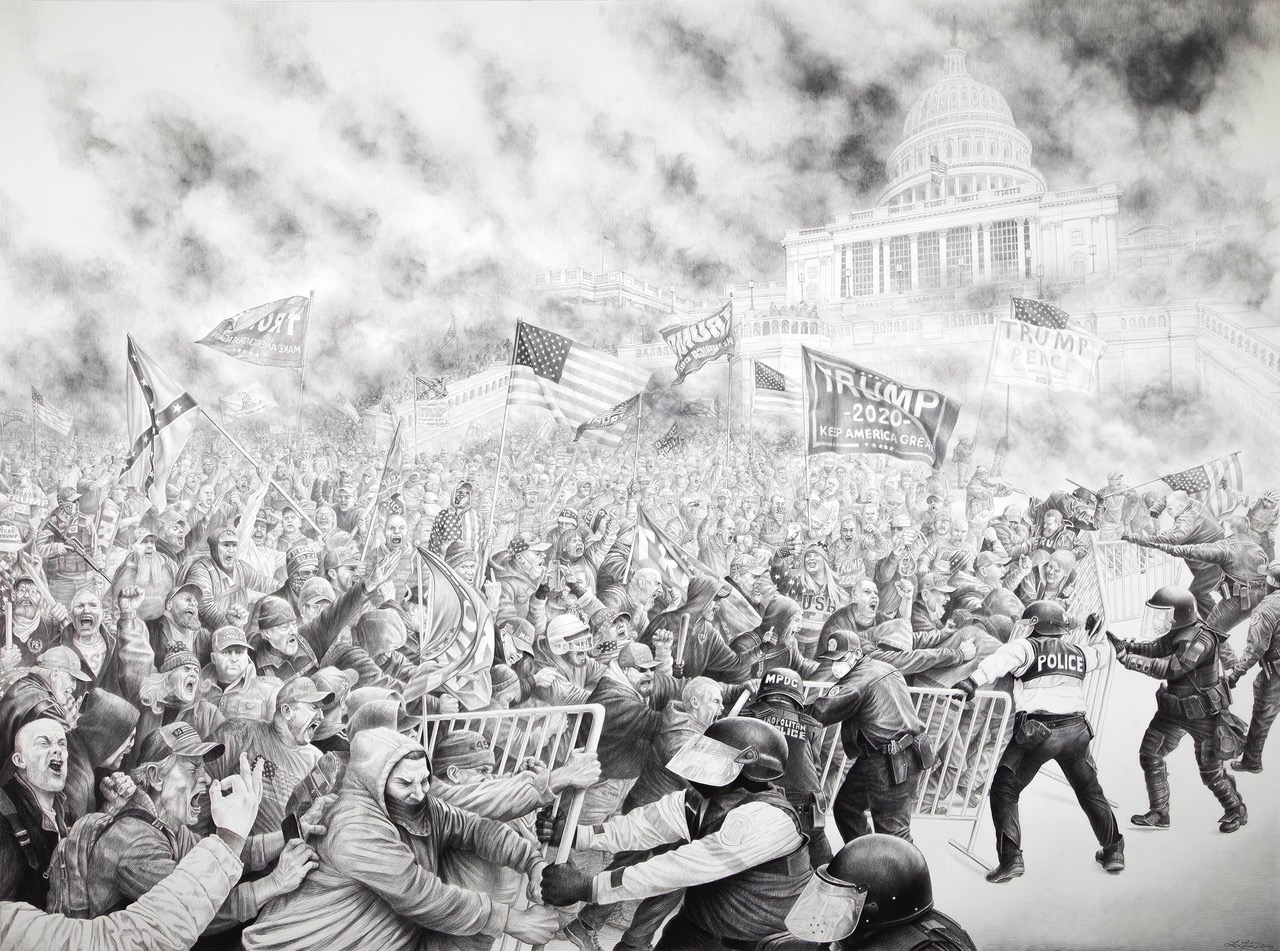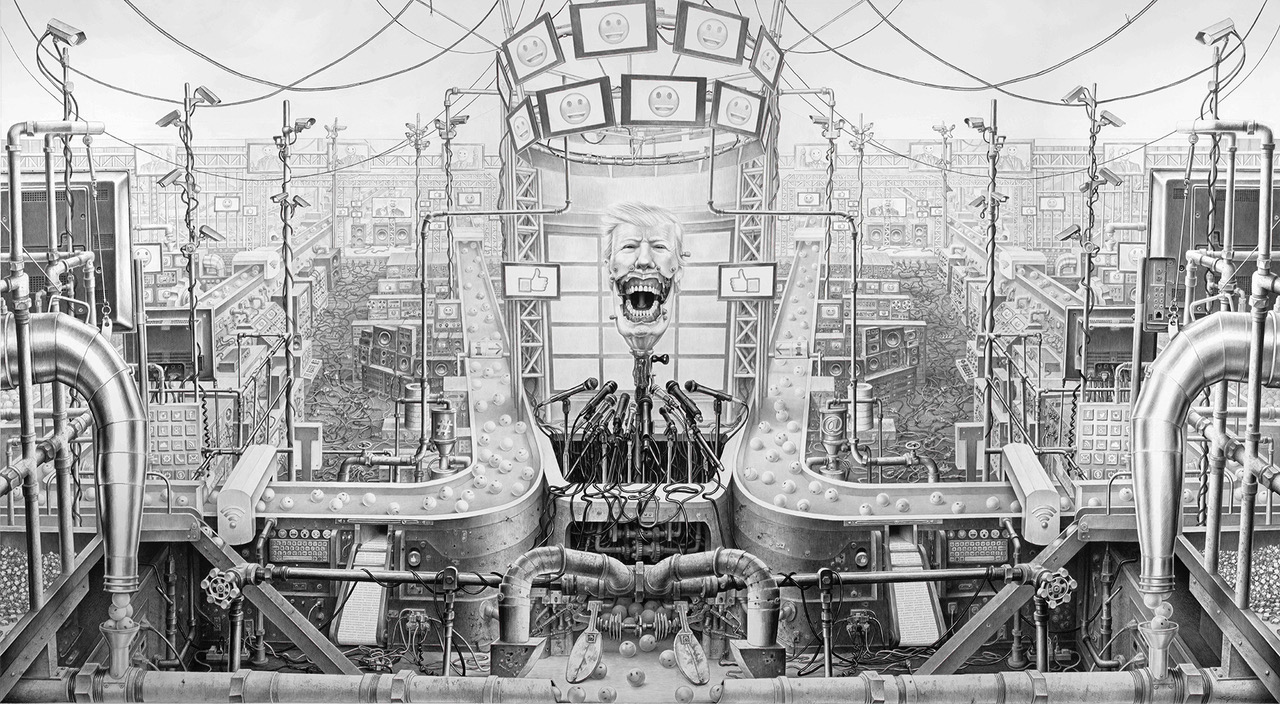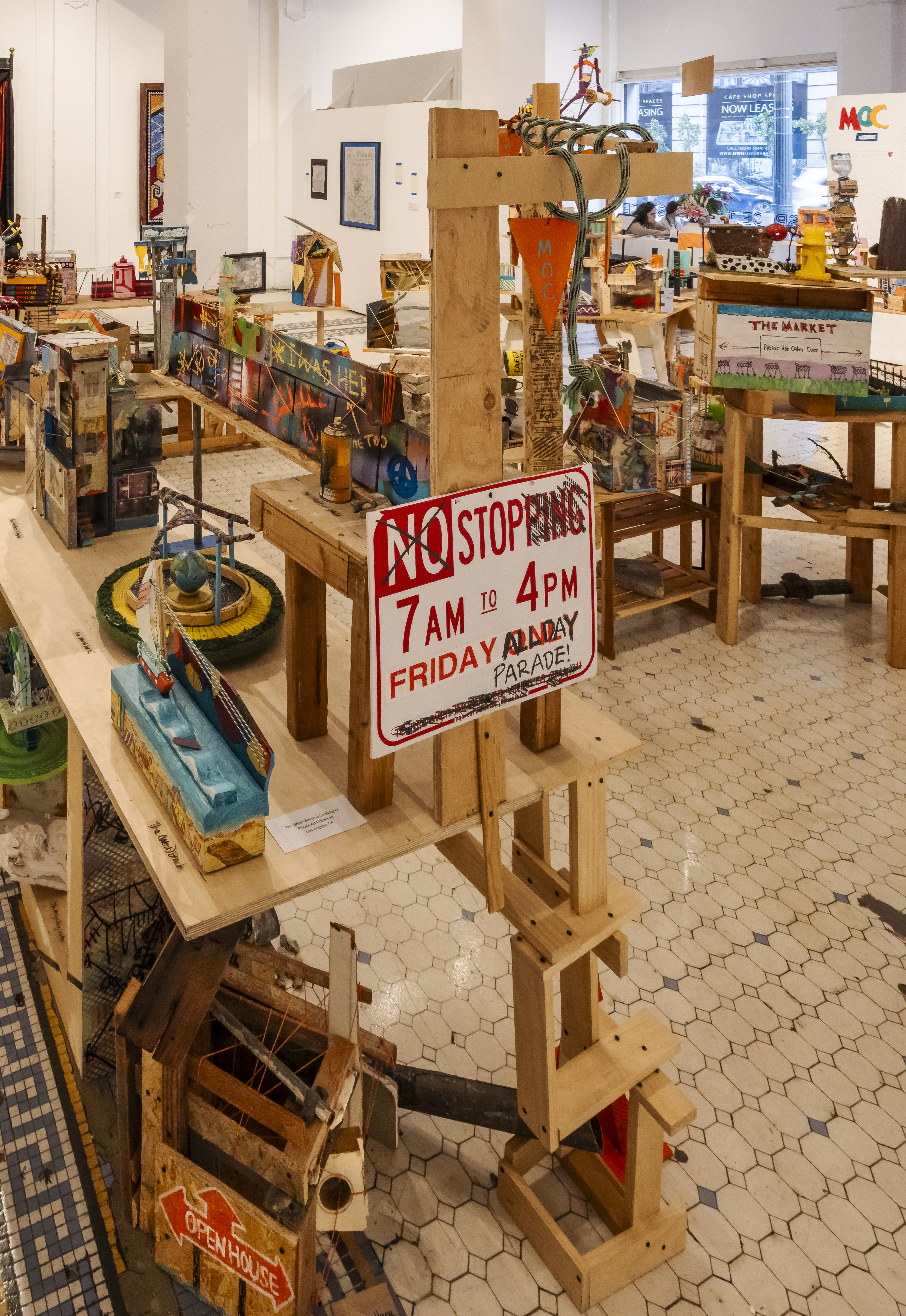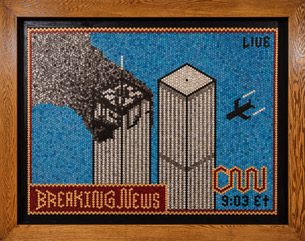Whitehot Magazine
October 2025
"The Best Art In The World"
"The Best Art In The World"
October 2025
Four Defiant LA Women Artists Have The Courage To Make Art That Is Fun: Laurie Lipton, Susan Feldman, Lili Lakich and S.C Mero, at Art/Space 114
 Laurie Lipton, America!America! 2022. Charcoal and graphite on paper
Laurie Lipton, America!America! 2022. Charcoal and graphite on paper
By LITA BARRIE June 10, 2025
Women’s art often has an obsessive quality. Darkness and Light is an expansive exhibition that shows how obsession can drive creativity: shaping artistic vision by providing an unwavering focus on high-level techniques for building upon meticulous details, repetitive patterns and creating spatial depth from layers of overlapping and interacting textures. Laurie Lipton transforms line drawings into graphite paintings, S.C Mero transforms pennies into glistening mosaic patterns, Lili Lakich transforms neon into electric drawings and Susan Feldman transforms discarded materials into her own fun loving, utopian city. Their artistic obsession is connected with their aesthetic compulsion to create an antidote to difficult times. Art has always been a powerful tool for processing deeply held emotions but in today’s disturbing political climate we are all on edge so that the urgency of obsessive art resonates with us. These badass artists push creative limits with visual and linguistic puns and absurdist twists on societal norms that are filled with sardonic humor. As the exhibition title suggests they share a light hearted approach to dark content.
The exhibition is installed in a cavernous new gallery in the iconic Hellman building: a 1903 Beaux-Arts style building with lavish marble inlay floors, corridors, maple hardwood and stained glass skylights in the lobby. The building was one of three historic bank buildings in a downtown L.A area dubbed “Old Bank District” that property developer extraordinaire Tom Gilmore purchased in 1998 and converted for adaptive reuse. Gilmore opened his vast gallery - Art/Space 114 - in December last year, with an exhibition of four LA male artists, Four Sight. He demonstrates his love and support of L.A artists by refusing to take any commission on art work sales.
Laurie Lipton is arguably one of the most gifted artists of our time. She has devoted her ascetic life exclusively to developing her remarkable drawing ability since she was six years old. Lipton received the first Fine Arts Degree from Carnegie Melon majoring in drawing, when AbEx, conceptualism and minimalism were the prominent trends - but she stubbornly stuck to drawing. She loved the egg tempera paintings by the Flemish masters, especially Jan van Eyck, and privately studied their techniques in the school library. Lipton bought the same type of two- and three- bristle sable brushes they used to create detail and texture. In her junior year abroad Lipton returned to drawing because it is second nature to her and stumbled upon a unique way of drawing: using hundreds of tiny, delicate, cross-hatched marks to build up form with a luminosity much like egg-tempura. Without any smudging of lines or room for imprecision she layers contours and shading with an exactitude that is the hallmark of genius - which cannot be copied or emulated because no one today has the chops to draw like Lipton. Her anachronistic technique is unique to her. Lipton’s work has evolved with her: from wickedly funny drawings of 1950s housewives with fake smiles, showing off their domestic appliances, followed by sardonic drawings about teenage sexuality and relationships created during her 36-year period of activity in Europe.
 Laurie Lipton, Post Truth, 2017. Charcoal and Paper
Laurie Lipton, Post Truth, 2017. Charcoal and Paper
Her mature style developed as a third chapter when she returned to L.A in 2012 and embarked on a more ambitious project of chronicling our times - which has earned Lipton high praise as “a modern day Goya”. Her phantasmagorical graphite paintings are horror stories about mankind abundant with Lipton’s signature motifs: tangled electrical cords, jumbled robotic contraptions, uncanny creatures that are part human and part machine. She explores technology’s role in disseminating disinformation and controlling people who are isolated in front of screens, scrolling through social media. Lipton’s imagery has a retro-futuristic quality often incorporating startling depictions of her own face with a bald head, like a mannequin. In Post Truth a depiction of Trump as a mechanical talking head with a large mouthpiece that is wrenched open wide, is surrounded by microphones in an industrial hell-scape with no spectators, only smiley and thumbs up emojis. America! America! is an epic depiction of the January 6th insurrection with an angry, riotous crowd brandishing flags and weapons, pushing down fences and the police officers who try to restrain them. The harrowing scene is filled with billows of gray smoke. Lipton is also adept at using light to evoke strong emotion and create atmospheric perspective.
 Susan Feldman, MOC (My Own City) 2023. Mixed Media installation
Susan Feldman, MOC (My Own City) 2023. Mixed Media installation
Susan Feldman creates her own utopian city: MOC (My Own City) where there is no place for sickness or crime or prohibitions - only wellness, conviviality, culture and fun. Feldman’s brightly colored city has 50 miniature structures - including private houses, public and community buildings - set on ramps and wooden beams at different heights so the viewer can wander through it. This immersive multimedia installation blends painting, sculpture and photography that recalls Red Grooms’ pop-art constructions of modern urban life, “Sculpto-Picto-Ramas”. Feldman avidly collects reclaimed wood, tinted plexiglass, found objects, old photographs, strings and ropes in her extensive treasure trove of source materials. MOC has a Hill house made of repurposed paintings, a Fun House for an artist with multiple levels that encourage expanding vision and a Neighbor's House with a roof-top garden for impromptu gatherings. Of course, it also has a school, a metro with emerald colored cars and a wellness pavilion instead of a hospital because people do not get sick in MOC. An art museum made from angled stretcher bars has a modern vibe and contains miniature Feldman paintings. A breakfast joint offers anything you want’ on the menu, a book haven contains “the best book ever”. A one world park on a rotating tray with a globe in the center, surrounded by a labyrinth even has a talking stick that allows everyone to be heard. MOC is a happy place which started off as a form of escapism in 2019 and turned into an all-consuming obsession to expand an imaginative city that embodies the concept of vive et vale ( live and be well) in a physical form to share her feelings of fun.
Lilli Lakich has been a pioneer of neon art since 1966 with a dedicated art career that extends from her own innovative art practice to co-founding the Museum of Neon Art ( MONA) in the Arts District in 1981. MONA is now re-located in Glendale and until 1999 her best known work based on the Mona Lisa adorned its frontage. This work is currently on view at L.A. Louver Celebrates 50 Years ( her solo exhibition was the gallery’s 1976 inaugural.) Lakich was attracted to neon signs in the landscape while traveling on the road as a military kid seeing flamboyant signs of cartoon cowboys lassoing calves and swimmers swan-diving into pools. She also loved the light through stained glass she saw growing up in Europe. Lakich learned how to draw with neon light to combine these two childhood fascinations. Her illuminated art is built in layers of lines, with the neon overlaid lines that light up the images as neon sculpture. Lakich unabashedly admits that she ”uses art as therapy” to document her “history of failed love relationships.” This process began while she was studying at Pratt after a devastating relationship that led to her first light sculpture: a self-portrait with tiny light bulbs controlled by a motor, blinking down her face like tears. The exhibition includes Chryssa Godmother of Neon Artists, an homage to the first neon artist who came to L.A from Greece and references her letter forms as an influence. The most explicitly political work, Abort, depicts Trump as a coat hanger. Lakich’s work is fluid balance of aesthetic experimentation, pop culture, personal biography and cultural history.
 S.C Mero, The Towers, 2021
S.C Mero, The Towers, 2021
S.C Mero is an interventionist artist who makes witty guerrilla art that appears unexpectedly outdoors on the streets or inside publicly viewed interior spaces in downtown LA, as a reminder that ordinary life has magic. The sizes range from a miniature diorama in a pothole, to a life-size cabinet full of curiosities that fills an empty storefront, to large-scale monuments. Her penny pieces employ alchemical techniques to transform tarnished old pennies. She strips the zinc and dirt off the copper with a power drill, cleaning them with a thin acid and applying a patina that makes them iridescent. Pennies have lost their monetary value but Mero lovingly beautifies them so that they acquire an aesthetic value. She glues thousands sparkling pennies together by laying them out horizontally on a frame to create an exquisite mosaic that references the art deco architecture in downtown L.A. In this exhibition her transformation of almost worthless money is viewed in an abandoned bank (which even has an abandoned bank vault in the floor below) challenging the viewer to contemplate what we truly value and how concepts of value change over time.
The Towers was made on the 20th anniversary of the 9/11 terrorist attack, in 2021 during the COVID lockdown. Mero explores the dark side of capitalism by depicting the terrifying scene in an intricate mosaic made from thousands of torched, polished and refinished Lincoln pennies - which signify lost monetary worth. This work is more impactful viewed in a gallery that is a refurbished bank. Mero is drawn to tragic-comedy historic narratives which explore imbalance on many levels. Girl in Water Tank is based on the tragic death of a psychologically unbalanced woman found dead in a water tank inside Hotel Cecil, a once famous 1920s hotel which is now a hostel. The accident happened in 2013 when the victim was visiting and off her medication. This poignant work explores the metaphor of a woman drowning in her own mind.
The four artists in this exhibition make art because they need to process otherwise uncontrollable emotions with highly controlled aesthetic techniques. Their obsessive, labor-intensive detailing, layered textures and lines gives their work an urgent authenticity that strikes a chord in us in a time when mainstream culture is so fake. Through June 22, 2025. WM

Lita Barrie
Lita Barrie is a freelance art critic based in Los Angeles. Her writing appears in Hyperallergic, Riot Material, Apricota Journal, Painter’s Table, ArtnowLA, HuffPost, Painter’s Table, Artweek.L.A, art ltd and Art Agenda. In the 90s Barrie wrote for Artspace, Art Issues, Artweek, Visions andVernacular. She was born in New Zealand where she wrote a weekly newspaper art column for the New Zealand National Business Review and contributed to The Listener, Art New Zealand, AGMANZ, ANTIC, Sites and Landfall. She also conducted live interviews with artists for Radio New Zealand’s Access Radio. Barrie has written numerous essays for art gallery and museum catalogs including: Barbara Kruger (National Art Gallery New Zealand) and Roland Reiss ( Cal State University Fullerton). Barrie taught aesthetic philosophy at Claremont Graduate University, Art Center and Otis School of Art and Design. In New Zealand, Barrie was awarded three Queen Elizabeth 11 Arts Council grants and a Harkness grant for art criticism. Her feminist interventions are discussed in The Encyclopaedia of New Zealand and an archive of her writing is held in The New Zealand National Library, Te Puna Matauranga Aotearoa.
view all articles from this author








